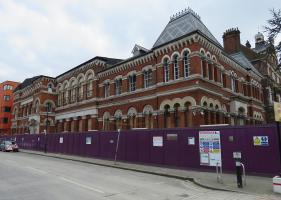
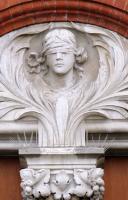
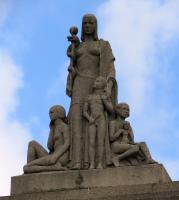
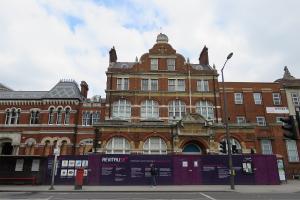
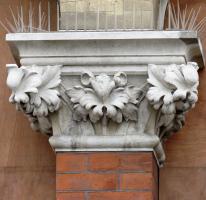
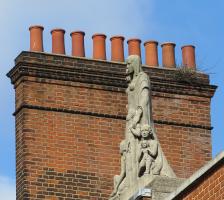
A few minutes from Elephant and Castle in South London is Walworth Road, and there by the junction with Larcom Road is the former Southwark Public Health Centre, now called the Walworth Clinic, of interest to these pages because of the sculptural group on top. The building is of 1936-37, thus Art Deco, and so is the sculpture, being a tall, triangular composition of a semi-nude standing woman with three children gathered round her. The central female figure is emblematic of Public Health, and carries in her hand, leaning against her side, a staff with a lively snake wound around it – this is the Staff of Aesculapius (Asclepius), symbol of health and medicine from Ancient Greek times. Her pose is typical for Art Deco, symmetrical apart from the arms, and looking almost straight ahead, without a twist to the pose or slant to the shoulders. Her figure, with wide shoulders, small breasted and flat torso, lender overall, is Art Deco too, as is the simplification of the features and the straight cut of the hair. (For more on the staff of Aesculapius, see the snakes page, and for allegorical sculpture of Health, see this page.)
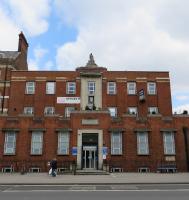
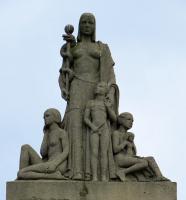 Walworth Road Clinic and Art Deco sculptural group.
Walworth Road Clinic and Art Deco sculptural group.
The three children are disposed as a pair of young girls, seated left and right, the symmetry of their positions – their heads are at the same height and they both look outwards – are varied in their poses, with one half-kneeling, hand pensively to chin, the other seated on a low plinth, holding a doll, unusual in sculpture. In front of his mother stands a thin boy, looking up at her, one hand holding some stick or flute, the other reaching up to hold her hand, his face gazing upward to hers – in an otherwise rather emotionless group, this gives a sense of filial affection, relating to the caring implicit within healthcare.
Sculpture by E.J. and A.T. Bradford, and details.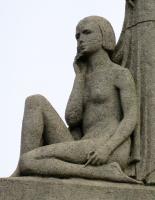
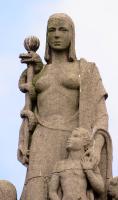
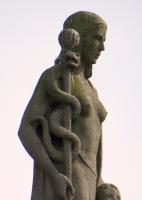
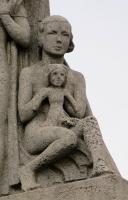
As a summit piece, the group is exposed to wind and weather in full, and already the surface is much pitted, and already the little boy’s hand, for example, is becoming worn away.
According to web information, which I have not been able to check but have no reason to doubt, this group is the work of E.J. and A.T. Bradford, sculptors and masons of Southwark, whose premises survive not far off, on Borough Rd – see bottom of this page.
The main Deco feature of the building itself is the central feature beneath the sculptural group, two storeys high, of fluted stone with a central window, the date 1937 above, and a curved canopy – there is a similar feature around the side in Larcom Street. The rest is of red terra cotta brick, akin to Edwardian building of some years before, with surviving minor decoration above windows and around the door, where there is a panel bearing the inscription ‘The Health of the People is the Highest Law’. The design was by Percy Smart, Borough Engineer at the time. The building has some historic significance as one of a few pre-World War II health centres presaging the National Health Service, introduced shortly after the end of the War.
Next to the Health Centre is the Southwark Central Library and Cumings Museum, red brick and stone edgings or dressings in a Queen Anne style, with arched windows below, rectangular above, dormer, ranked chimneys and a central gable with curvy edging. Edward l’Anson was the architect, and the dates are 1892-93, with the museum an addition of 1902-06. The whole forms a centrepiece to the group of buildings formed with health centre built later on to the right, and the earlier Municipal Offices noted below, on the left, being both taller and projecting forward. Only minor carving though – the heavy doorway has leafy spandrels, and there is minor carving above and next to the ground floor arches and higher up.
Southwark Central Library and Cumings Museum, by Edward l'Anson.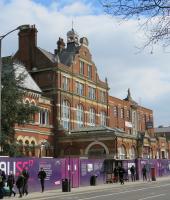
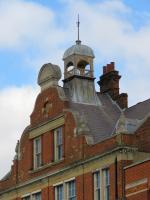
To the left then, we have the most physically impressive and earlier building of the group, originally a Vestry Hall, and for a time the Town Hall, designed by Henry Jarvis and put up in 1864-65, with an extension in about 1900 (a small church by Jarvis, later destroyed, is depicted at the bottom of this page). A heavy mid-Victorian design with squat corner towers bearing tall mansard roofs, these of slate and the bulk of the building made in red brick and white stone dressings, stretching far back along the small road called Wansey Street to the side.
Henry Jarvis's former Vestry Hall, high Victorian with sculpture.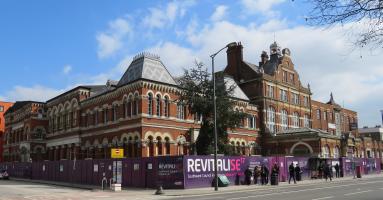
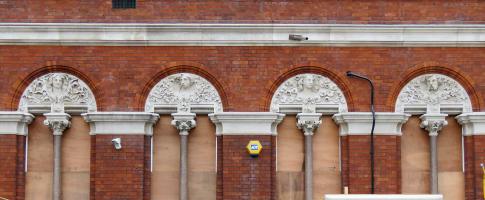
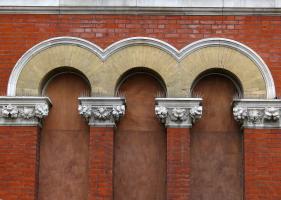
The interest of this building is the tops of the arches on the heightened ground floor, which contain sculptural decoration, continued in minor form higher up. In the arches are decorating designs of leaves, different to each arch, with central carved heads staring out and to the sides. Beneath these are thin granite-shafted pillars, with the capitals carved with further foliage. There are eight arch carvings in all, and rather more capitals to the pillars – there are more of the same at second floor level, and minor decorative cut-out scrolling above several of the windows. The quality of the leaf carving is good – note especially the oak leaves and acorns, the olive branches, the coiled-up ferns, and the figs. The sculptured heads are rather bland, or perhaps have been restored over zealously shaving off the detail along with the decayed stone, and are simplistic in the extreme – I do rather think it is poor restoration, because the surrounding leaves are of so much better quality. And one of these heads, a little damaged and unrestored, is better than the others – she is Blind Justice, with a ribbon tied over her eyes, and charmingly knotted on the right hand side - see picture at top of page, and for more renderings of Justice in sculpture, see this page. We may also note one of the male heads, a Herculean personage wearing a lion's head and skin over his own, a symbol of Government, see picture below - for more such things, see bottom of this page.
Some of the sculpture in the arches, heads and carved foliage (click to enlarge).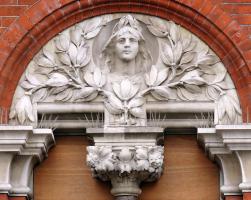
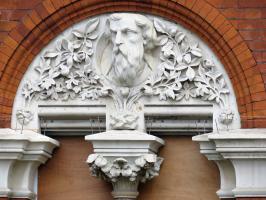
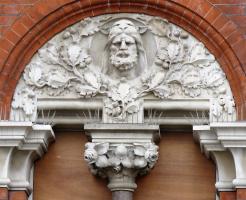
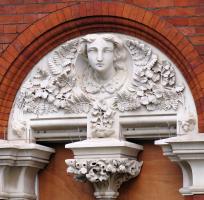
Go along Walworth Road to St Peter's Church, Walworth, // or west and then south along Kennington Lane to Durning Library // Go North and past Elephant and Castle to Trinity Church Square and thence to Borough High Street // or south and east to Wells Way in Burgess Park
Borough to Bermondsey: churches and sculpture // London sculpture // Architects
Visits to this page from 5 April 2016: 6,916